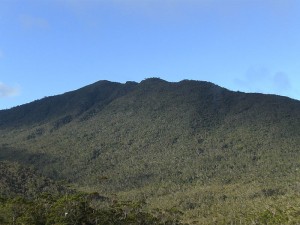Mt. Hamiguitan being considered as Unesco world heritage site
MANILA, Philippines — Known as a nesting place of the endangered Philippine Eagle and home to a forest of century-old pygmy trees or bonsai, Davao Oriental’s Mt. Hamiguitan mountain range may well take its place among the world’s natural heritage sites soon.
The Paris-based United Nations Educational, Scientific and Cultural Organization (Unesco) is expected to deliberate on the classification of the 6,834-hectare Mt. Hamiguitan Range Wildlife Sanctuary, which has a peak that rises 1,620 meters above sea level, as a World Heritage Site next year, the Philippine Embassy in France informed the Department of Foreign Affairs this week.
During meetings in Phnom Penh, Cambodia this week, Unesco’s World Heritage Committee, which convenes once a year to evaluate new sites, has asked the Philippines to formally file additional information to back its nomination of Mt. Hamiguitan, signaling progress in the country’s quest to include the mountain range on the prestigious list.
“After deliberations during the currently ongoing 37th Session of the World Heritage Committee, the Philippines was requested to formally submit information related to land claims and the expanded boundaries of the property,” the DFA said in a press statement on Tuesday.
“The Mt. Hamiguitan nomination was therefore referred for discussion possibly in next year’s World Heritage Committee meeting. It is expected that once the Philippines submits all the requested additional information before February 2014, consideration for inscription will be undertaken in June 2014,” the foreign office said.
Philippine Ambassador to France Cristina Ortega, who is also the country’s permanent delegate to Unesco, led the Philippine delegation to the Unesco meetings in Phnom Penh. The Philippines, one of 190 state signatories to the 1972 convention on the protection of the world’s cultural and natural heritage, is currently an observer on the World Heritage Committee.
According to Unesco procedure, two advisory bodies mandated by the World Heritage Convention—the International Council on Monuments and Sites and the World Conservation Union—are expected to evaluate the Philippines’ nomination of Mt. Hamiguitan.
Once included on the list, the Unesco said, “the resulting prestige often helps raise awareness among citizens and governments for heritage preservation.”
“A country may also receive financial assistance and expert advice from the World Heritage Committee to support activities for the preservation of its sites,” Unesco said on its website.
Declared by law as a Wildlife Sanctuary in 2004, Mt. Hamiguitan is a protected area that straddles the municipalities of Mati, San Isidro and Governor Generoso in Davao Oriental and is home to a unique 600-hectare forest of bonsai trees, among a total 1,380 species of flora.
Critically endangered plant species, including the Shorea polysperma and Shorea astylosa trees, and the Paphiopedilum adductum, an orchid variety, are found on Mt. Hamiguitan’s slopes.
These species are on the Red List of Threatened Species of the International Union for Conservation of Nature, considered a world authority on the conservation status of plant and animal species around the world.
The range also cradles 341 species of fauna that are endemic to the Philippines, including the Philippine eagle and the Philippine cockatoo, both also on the IUCN Red List.
Mt. Hamiguitan is currently on Unesco’s tentative list of World Heritage Sites following the Philippines’ nomination in 2009.
In justifying the nomination, the Unesco National Commission of the Philippines cited the range’s significance to the country as the seventh among 17 biologically rich countries of the world.
“The site represents the fast disappearing habitats of globally important species of plants and animals…. At the national level, this sanctuary is a conservation interest. At a global scale, it is known to be a habitat of globally important species of plants and animals,” reads the Philippines’ description of the mountain range on the Unesco World Heritage Site’s tentative list.
During the Cambodia meetings, the Unesco committee also lauded the Philippines for its multi-sectoral effort in protecting and conserving the range, particularly coordination among the provincial government of Davao Oriental, the Department of Environment and Natural Resources and indigenous people.
Currently, the Philippine has five sites on the World Heritage List, including the Tubbataha Reefs Natural Park, the Puerto Princesa Subterranean River National Park, the Rice Terraces in the Cordilleras, the town of Vigan in Ilocos Sur, and the country’s Baroque churches.
There are some 967 cultural, natural and mixed properties on the list of World Heritage Sites, notable among them the Great Wall of China, the Galapagos Islands off Ecuador, the Acropolis in Athens, Greece, Mt. Etna in Italy and several national and state parks in the United States, including the Grand Canyon, the Everglades, Yellow Stone and Redwood.
